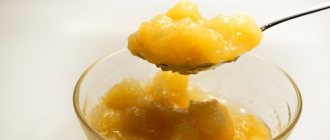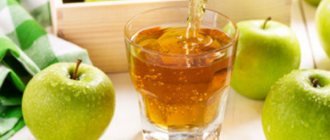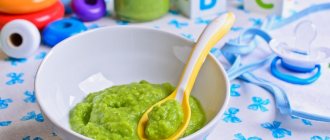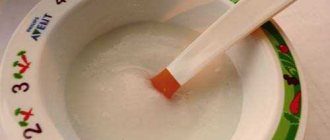Where to start complementary feeding
Proponents of the old and new schools of pediatrics argue about whether to give baby purees from 4 months or from 6 months. But they unanimously say that it is best to start complementary feeding with fruit and vegetable juices, since the consistency of this substance is liquid, like milk. Fruits contain a lot of vitamins and fiber, which a child needs for the proper functioning of the gastrointestinal tract. As a rule, complementary feeding of a child begins at four months, but opponents argue that at this age the child’s body is not yet ready for foreign food other than milk. Juice acids can cause allergic reactions that will be difficult to combat.
Adherents of the modern school of pediatrics adhere to broader views. In addition to juice, which is considered beneficial, the child can be given fruit and vegetable purees, as well as porridge, as additional food. There is no clear answer as to which baby puree from 4 months is best. It is important to choose the optimal taste and follow the norm.
If you don't know exactly when to start complementary feeding, some signs will help you:
- the child is already holding his head independently;
- tries to put toys or any other objects in his mouth that get in his way;
- if the baby watches the adults’ meals with special attention and shows constant interest in adult food;
- if the baby opens his mouth on his own when the spoon approaches his mouth;
- if you see that your baby is hungry between feedings of milk or formula.
Also, doctors and more experienced mothers who have already gone through the agony of starting complementary feeding advise introducing vegetable purees into the diet. If you start with fruit sweets, the child will get used to them and will no longer agree to swallow a tasteless, insipid vegetable porridge. This turns into real torture not only for the child, but also for the parents. And vegetable puree is absorbed several times better. The composition of vegetables is as close as possible to the enzymes of gastric juice, and the absorption of food will take place practically without bloating. This is especially important for parents who have suffered with infant colic.
In any case, when introducing baby purees into the menu from 4 months, you must rely on your own observations of the baby’s behavior and eating habits.
The sequence of introducing foods during breastfeeding
Infants, who from birth are accustomed only to breast milk, accept new products with dissatisfaction.
However, at the age of 6 months, there is not enough milk in the breast, it is less nutritious, and the child asks for more. Complementary foods should be offered after milk intake.
The only rule for introducing complementary foods is that any new product is introduced at 5 g/day . Gradually the volume increases to 100-150 g/day. So, where to start feeding a baby at 4 or 6 months?
Complementary feeding chart for a child from 6 months to one year
| Age | Products |
| 6 months | Vegetables: zucchini, cauliflower, pumpkin, broccoli, carrots. |
| 7 months | Dairy-free porridges: rice, buckwheat, corn, oatmeal. |
| 8 months | Meat: turkey, rabbit, veal, beef, chicken, lamb. |
| 9 months | Cottage cheese, kefir. |
| 10 months | Fruits: apple, pear, prune. |
| 11 months | Fish: cod, hake, pike perch. |
| 12 months | ½ egg |
Rules for early complementary feeding
It is impossible to immediately determine which baby puree from 4 months is better. It is necessary to observe the baby and select flavors, focusing on the mood with which the child absorbs the next spoonful of puree. There are several rules that will make it easier for mothers to introduce additional nutrition.
- It is not recommended to give two or more products at the same time. This is explained by basic safety rules. If, for example, a baby develops an allergy at first, it will be difficult to determine what product it started with. The range of baby purees from 4 months is huge, but it’s best to start with a simple zucchini or pumpkin, and then introduce something sweet in the form of apple or apricot puree.
- It is better to give complementary foods a few minutes before breastfeeding. This way, small portions of additional nutrition will be better absorbed and you can gradually increase the dose.
- You need to monitor the consistency of the food. The softer it is, the better it passes through the narrow, delicate throat.
- Gradually, the amount of food should increase, it should become more and more varied, since a growing body requires an increased number of calories.
Be sure to remember that you should only introduce a new product when you are completely sure of its health. If your baby develops an allergy while using any product, get rid of it first. Then, after a few days, you can try new things.
Start of feeding
Almost every young mother dreams of starting complementary feeding as soon as possible, because this means that the baby becomes mature and interesting, begins to try adult food and explore a new world. However, one should not rush in this matter, so as not to injure the child’s still unformed intestines and not to disrupt the fermentation function.
At first, you should limit yourself to half a teaspoon of vegetable puree. It is better to choose zucchini or broccoli. These vegetables are neutral and suitable for almost all babies. It is preferable to give from a soft spoon. Firstly, it does not injure the mouth, and secondly, it looks like a warm breast. Next, most mothers face a big, serious problem. Children either spit out food that is new to them, or swallow very little, and the rest goes into the trash. Don't worry. Remember that each organism is individual in its development, some need more time to get used to new tastes and textures, while others will take a spoon from their mother’s hands and demand more. Not a single mother knows exactly how to feed a baby puree at 4 months. Don't give up, try again and again.
As a rule, children's doctors recommend vegetable purees for children from 4 months to start complementary feeding, because most vegetables are green and have less sugar. The already mentioned pureed zucchini, broccoli or cauliflower, spinach or asparagus are excellent. But no matter how good the rating of baby purees from 4 months is, homemade food, even for the first feeding, will still be better and tastier. And all because mom will prepare the puree with love and care.
How much of what
Now here are some recommendations for the amount of food:
- Vegetable/fruit puree (in grams): first day – 5, second – 10, third – 15, fourth – 20, fifth – 50, sixth – 90-100, seventh – 120. On the last day, one complementary food can replace one feeding .
- Porridge (in grams): first day – 5, second – 10, third – 15, fourth – 20, fifth – 50, sixth – 80, seventh – 100-120.
- Juice: over the course of a week, the amount per teaspoon is increased to 40-50 ml.
When introducing complementary foods, do not forget that it is better to give it in the morning and for an afternoon snack, and breast milk or formula is provided in the current volume (800-900 g). The slightest allergic reactions and excessively loose/hard stools are a reason to cancel the new product and look for a substitute from the available variety.
The World Health Organization recommends starting complementary feeding for breastfed babies at 6 months of age. Earlier dates (up to 5 months) are relevant for babies who are bottle-fed. It's not uncommon for young mothers and fathers to start trying adult foods as early as 4 months. Is it worth taking such a risky step? Is the child’s body ready to accept new food? How can you make the first adult meal safe for your baby?
Cooking at home
You can prepare puree for a 4 month old baby at home. Mothers who are on maternity leave and have enough time can afford this. Before preparing the puree, the selected vegetables or fruits must be thoroughly rinsed with boiling water. Peel and remove seeds from hard vegetables and fruits. Doctors advise using only simple vegetables, such as zucchini, pumpkin or carrots.
Selected vegetables or fruits must be cut into small pieces or slices and placed in boiling water. It is better, of course, to use modern kitchen appliances such as steamers, which retain the maximum amount of useful elements. However, if you don’t have it, you can use regular boiling water. Boil the vegetables well until completely softened. Drain the water and let cool. Then, without adding salt, sugar or spices, grind in a blender.
The following shows the ranking of products as their popularity increases.
Puree "Spelenok"
The well-known company for the production of natural juices and fruit drinks, Sady Pridonya, also produces infant formula for feeding babies up to one year old under the Spelenok brand. The brand has its own gardens not far from the main production. This allows not only to produce products at a minimum cost, but also to preserve all the beneficial properties of vegetables and fruits, because the distance from the garden to the laboratories for the production of mixtures is very short. “Spelenok” is included in the rating of the best baby purees from 4 months not only in Russia, but also in neighboring countries. The puree contains only natural one-component products: zucchini, carrots, apples, pumpkin, cabbage. Non-GMO, without adding any spices, salt or sugar.
"Spelenok" produces not only purees, but also children's fruit drinks, nectars and just water. Manufacturers strictly monitor product quality; indicators are monitored using computerized technology. For ease of use, all products are available in two types of packaging: glass and cardboard. Glass with a convenient lid can be used at home, and the puree in small cardboard packages can be taken with you for a walk or on the road.
All reviews about baby puree from 4 months “Spelenok” are not artificially inflated, only real reviews from mothers who are satisfied with the product and the result. According to general surveys, almost 90 percent of parents prefer to use baby foods from domestic manufacturers. According to them, the quality is in no way inferior to European analogues, despite the fact that many are confused by the rather low price of 25-30 rubles per unit at retail. But after trying, parents are convinced of the high quality of purees and juices.
"Agusha"
There are no parents who have not heard of Agusha baby puree from 4 months. registered a new brand back in 2001 and has since occupied one of the leading positions in the production of baby food. Products under the Agusha brand are presented in three categories. The “first spoon” includes purees for the first feeding of meat, vegetables and fruits, water, biokefir for good digestion of babies, as well as juices.
The second category is represented by yoghurts, cereals and purees with a more complex and dense consistency. This is a transition to a more solid diet. And finally, the third category includes dairy products and cottage cheese for children over two years of age.
The Agusha brand cooperates with the Russian Union of Pediatricians and carefully monitors the quality of the complementary foods produced. More than once the company has won prizes at international manufacturing competitions.
Which puree is best to buy for first feeding?
To find out for sure whether your baby is ready to introduce complementary foods, you need to consult a doctor. You cannot ignore it if a child refuses food and spits it out. It may be worth postponing the introduction of complementary foods to 1-3 weeks later.
Before buying baby food, you need to carefully study the label. The composition should not contain preservatives, flavor enhancers and palm oil. To restore intestinal microflora, products with added vitamins are suitable. It is important to look at the expiration date. And also choose content that is well absorbed at a certain age.
According to buyers and pediatricians, the following judgments about manufacturers can be distinguished:
- Inexpensive purees - products;
- The product for children of any age can be purchased from;
- Purees for children from 5 months offers;
- Gerber food is suitable for those who value convenient packaging;
- Premium products include purees from the Semper brand;
- Natural purees with no additional ingredients can be purchased from Hipp;
- Heinz offers the most vitamin-rich purees;
- To stabilize the digestive system, nutrition from Agushi and Hipp is recommended.
The rating will help you choose mixtures that can replace natural feeding. And reviews from parents and specialists will help you choose the right food for your child.
Baby food "Frutonyanya"
The rating of baby purees from 4 months would not be complete without the most famous and competitive brand of baby food, Frutonyanya. The brand appeared about ten years ago in Russia and over the past few years has won the trust of mothers throughout the post-Soviet space.
The brand has a huge range of delicious products for babies: purees, juices, specially soft water, yoghurts and dairy products, cocktails and cereals. A children's menu is being developed together with the Union of Pediatricians of Russia, so each package can be labeled accordingly.
The domestic manufacturer does not particularly fantasize with the composition and offers standard purees of broccoli, carrots, squash, pumpkin or spinach with a small amount of water, without salt and sugar, to start complementary feeding. The meat purees, of course, use turkey, the lightest meat rich in essential minerals.
Parents whose children have already tried the mixtures offered by Frutonyanya are all satisfied. There are especially many reviews about the convenient packaging. Each jar has a protective film that prevents dust from getting under the lid. The lid itself is airtight, closed under high pressure. Interestingly, on each jar you can find special markings for grams. This makes it easier for mothers to count how many spoons in grams their baby has eaten today. This helps to keep a kind of record and accurately calculate the time for complicating the menu.
Complementary food "Heinz"
American is widely known all over the world. The range of products provided to the market is aimed at different areas of food consumption. Most often you can find the brand when buying sauces and baby food.
Heinz baby food products are manufactured in Italy, despite the fact that the company is American. This is not surprising, since Italian technologies for the production of such a delicate product as baby food are considered the best in the world.
The Heinz line of baby purees is quite standard. This is a puree of vegetables and fruits. The depth of the line is very wide. For the first feeding, you can buy one-component purees of green beans, apples, spinach, zucchini and carrots. With a gradual increase in the percentage of complementary foods in the diet, you can safely add multi-component mixtures, both vegetable and fruit. All products are made from environmentally friendly raw materials, because Heinz has its own extensive fields. High-tech computer equipment in production clearly monitors all stages of production in order to give the child a clean and healthy product.
A modern mobile application is widely used among parents. The program will help you create an optimal schedule for transitioning to complementary foods. The utility relies on the child’s data, which must be entered in special fields. Reviews about the application are positive; mothers in Russia use this assistant and recommend it to those who still doubt the benefits of the application.
Baby puree "Gerber"
Widely known all over the world, in addition to everyone’s favorite chocolate, several years ago it entered the baby food market. The range of baby purees from 4 months is very wide:
- Meat puree. At Gerber it is represented by turkey meat. During this period, a growing child's body really needs iron and sodium, which is found in large quantities in meat, and especially in turkey. Poultry meat is rich in fatty amino acids, zinc, iron, and excellent quality protein that is easily digestible. In addition, turkey meat contains a high sodium content. It is sodium that is involved in the creation of blood plasma and allows other vitamins to be quickly absorbed. You should start complementary feeding with one teaspoon. When opening, be careful to make sure it clicks. Baby puree from 4 months “Gerber” is completely natural, does not contain salt or spices. Store no more than a day in the refrigerator.
- Vegetable purees. This line is represented by several items. You can choose puree from cauliflower, broccoli, zucchini, pumpkin. All baby purees from 4 months are highly purified and are produced without the addition of starch or any flavor enhancers. It is very important that all purees are one-component, which means that there is nothing in there except the same zucchini, ground with water. You can store the jars for only a day after opening, so don’t feel sorry if your child has eaten almost nothing. Complementary feeding is a complicated matter, and if your baby is not yet ready to consume a whole jar in a day, take your time.
- Fruit puree. The most favorite and delicious. Let me tell you a secret, mothers of babies often like to feast on these children’s supplements themselves, because they bring nothing but benefits. Among the fruit varieties of "Gerbera" you can choose both single-component varieties and double ones, for example, apple with plum, apricot with rose hips, apple and banana. One-component purees are available in a wide range of flavors. Everyone’s favorite applesauce is also best given to a 4-month-old baby in moderation at first.
Is it possible to have fruit juices, meat, eggs
Complementary feeding for bottle-fed infants at 4 months should be based on the norms and rules for the gradual introduction of new food into their menu. Vegetable purees and cereals perfectly prepare the child’s gastrointestinal tract for consuming more protein-rich foods. The body expends more energy to digest protein. But at the same time it receives building material for the whole organism.
Protein products, for example, cottage cheese or meat, according to the pediatric complementary feeding system, are recommended to be offered to an infant at least 8 months old, since untimely introduction of foreign protein can cause allergies, irreversible damage to undeveloped kidneys, metabolic acidosis and dismetabolic nephropathy.
The introduction of protein foods should be done in small doses, almost in crumbs at the rate of 3–6 g/kg of the child’s body weight, gradually increasing the dose.
Egg yolk has been credited with wonderful properties since ancient times, and this is quite justified. It contains more than 30 elements that are vital for a growing body, but it is permissible to offer it to a child only at 9 months, since egg products are considered a strong allergen.
This product should be introduced into the baby’s diet gradually and in tiny doses, reaching the consumption of a quarter of an egg yolk per feeding no more than 3 times a week by the age of one year.
A chicken egg and a quail egg are practically no different in their nutritional value, however, it should be noted that salmonella cannot develop in quail eggs, their shelf life is longer, and the size and appearance of the product is ideal for first feeding, since it is small in size and attracts the child with its unusual appearance.
Some mothers tend to think that quail eggs are less allergenic, but this is not the case, and the prevalence of an allergic reaction to them, according to statistics, is lower, since the product itself is not as widespread as chicken eggs.
When choosing an egg, you should give preference to a fresh product with a clean shell. It is absolutely forbidden to drink eggs raw, and you need to boil the egg for more than 10 minutes. If blood is found in the baby's stool, this may cause salmonella infection.
It is strictly forbidden to offer egg white to a baby in the first year of life, because of its ability to cause severe allergic reactions, and the child’s immature digestive system does not have the ability to digest it.
The main signs of allergies that should not be ignored:
- rash on the child’s skin;
- upset stomach, diarrhea;
- painful sensations in the abdomen;
- shortness of breath, difficulty breathing;
- itching
It should be noted that there is great benefit in consuming the yolk of poultry eggs, however, when introducing it, extreme caution should be exercised both in volume and in preparing the dish for the baby before use.
It is recommended to include fruit juice in the child’s menu when he reaches 10–11 months, and it should be offered to the baby for second breakfast or afternoon snack, since it contains a large amount of sugar. The juice must undergo heat treatment.
They sing to the child only from a mug and only during feeding, so by the time the juice is introduced the child must master drinking from it. By the age of a baby, the permissible volume of fruit juice consumed should be no more than 200 ml.
Reviews from parents
Parents' reviews of Gerber puree (according to the results of our rating, recognized as the best) are extremely positive. Over the several years of its existence, there have been no scandals with the brand; its reputation as a manufacturer of natural complementary foods is absolutely fair. Mothers who fed their babies puree talk about the high quality. There is absolutely no salt or spices, as indicated on the package. Many people are pleased with the small packaging. According to mothers, at first, children eat very little and they don’t want to leave an almost full jar for later. I would like to give my child something fresh, just opened, but it’s also a pity to throw away almost a full package. Some experienced parents suggest sharply deep freezing opened baby purees. This method takes place. It is only important to follow food safety rules and not defrost the puree several times. The cost of a new jar is on average 35 rubles, and this is a disproportionate amount compared to the child’s health.
Useful video about complementary feeding at 4 months
List of sources:
- Komarovsky E. O. The health of the child and the common sense of his relatives, 2010.
- Cave Simone. Your baby week after week. From birth to 6 months.
- Zhernosek V.F., Dyubkova T.P. Feeding healthy children in the first year of life: educational method. allowance. – Minsk, 2008. – 48 p.
- Michaelsen KF, Weaver L, Branca F, Robertson A. Feeding and nutrition of infants and young children: a method. WHO recommendations. – Copenhagen, 2001. – 369 p.
Author
Oksana Belokur
Pediatrician
In 2012 she graduated from the Medical Institute of Sumy State University. She received a higher education in the specialty “Pediatrics” and qualified as a doctor. In 2012-2013, there were treatment and preventive activities at the Sumy Regional Children's Hospital. In 2013-2015 worked as a local pediatrician at Children's Clinic No. 2. I am currently on maternity leave. In my free time I do embroidery and knitting, and study English.
Share










